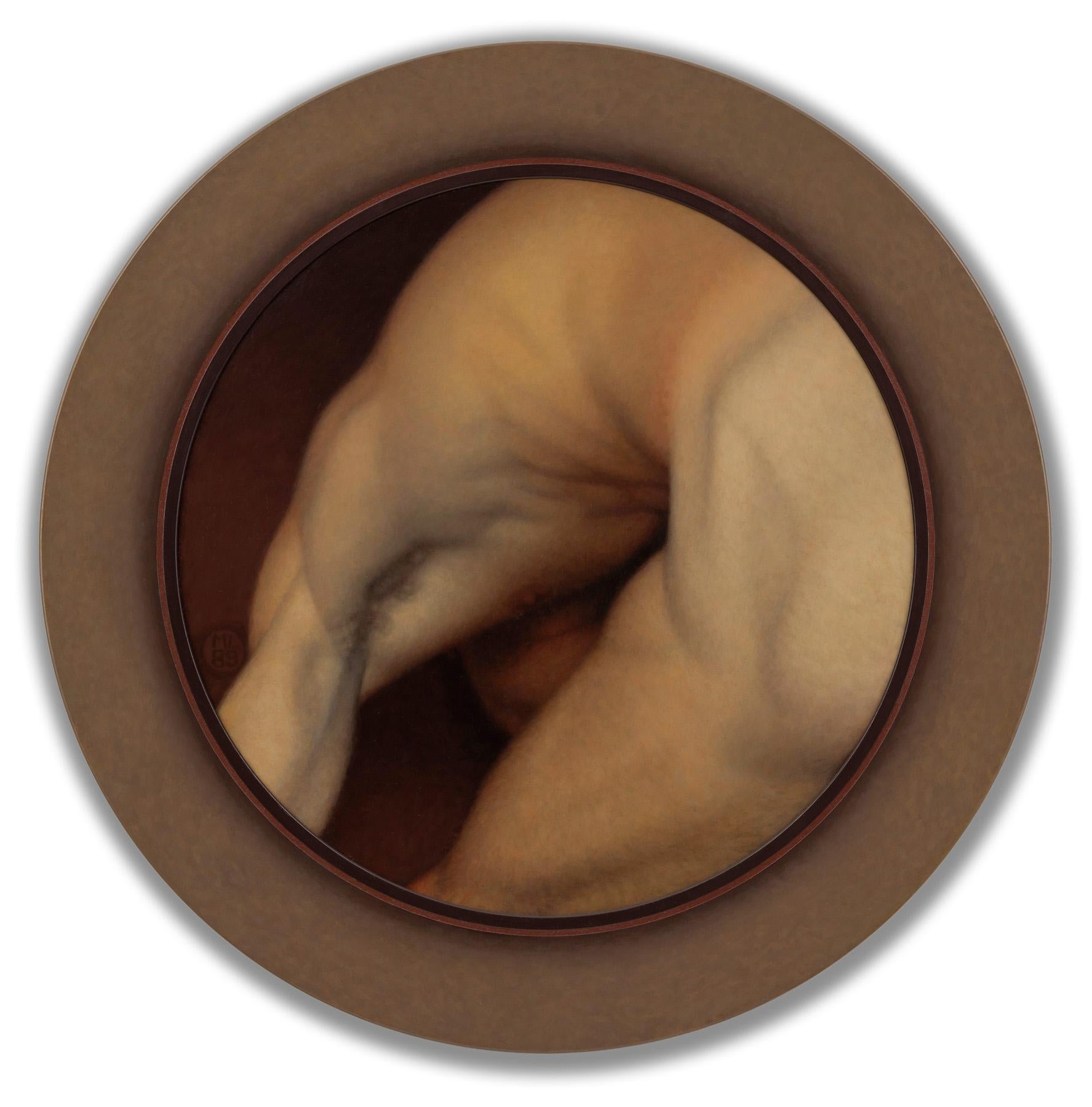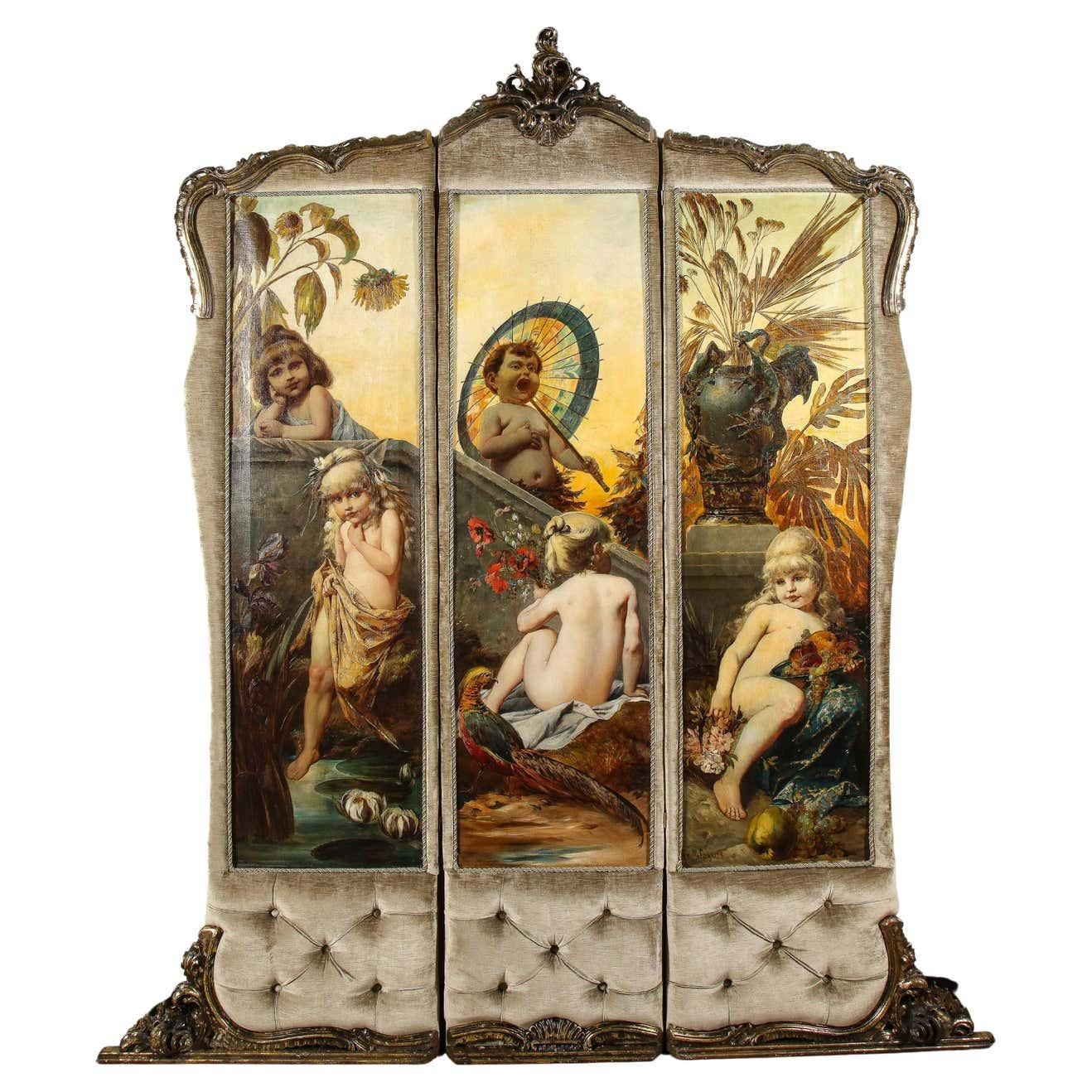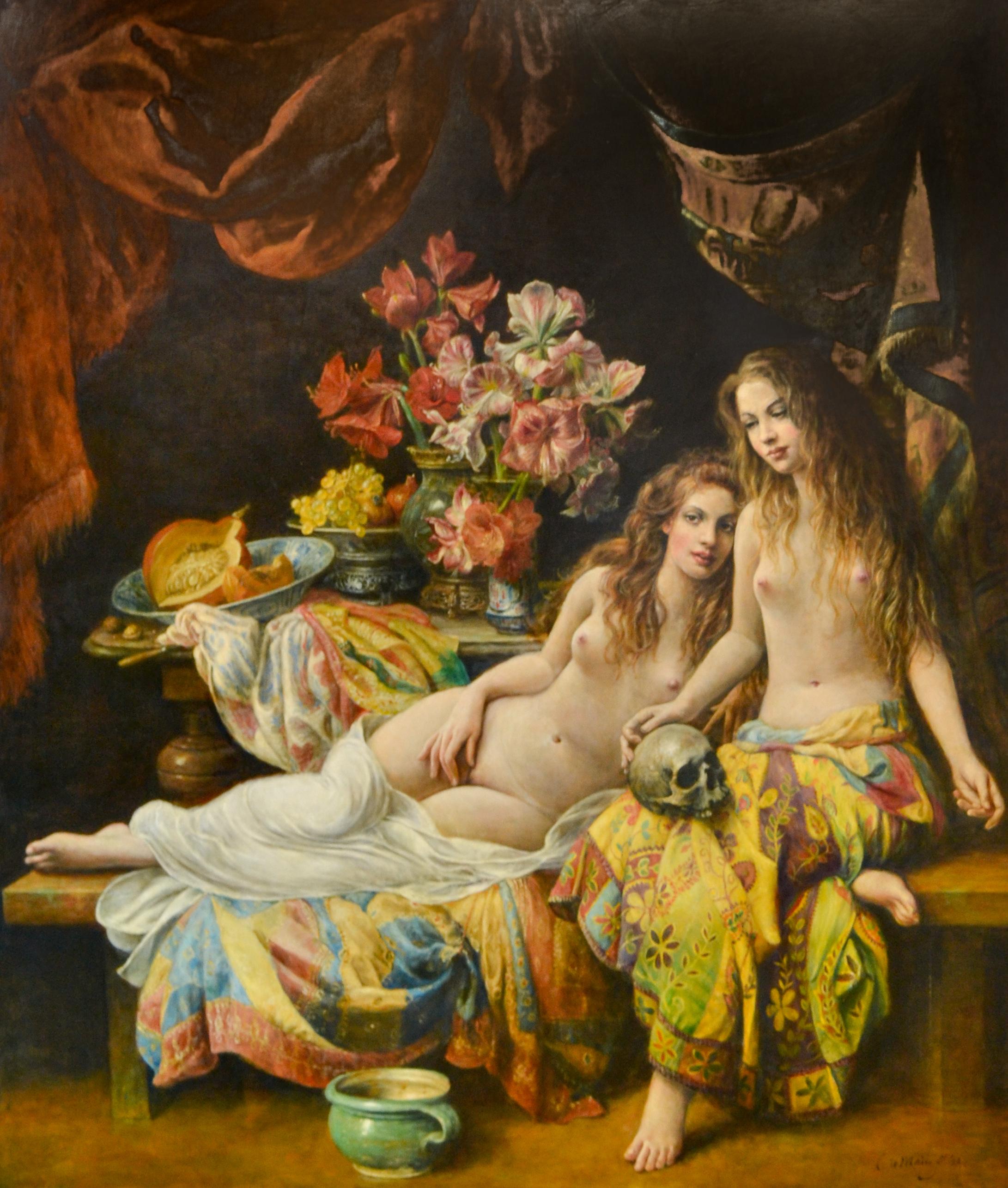Items Similar to Classical 19th century French Nude of a lady in the Barbizon Forest landscape.
Want more images or videos?
Request additional images or videos from the seller
1 of 13
Leon RichetClassical 19th century French Nude of a lady in the Barbizon Forest landscape.
About the Item
Classical 19th century French Nude of a lady in the Barbizon Forest landscape.
Richet spent much of his adult life in Paris. It was there that he met and became a student of Jules Lefebvre. He also became a disciple of Diaz la Pena. Both of these teachers were well-known proponents of the Barbizon School. The Barbizon school of painters was part of a movement towards Realism in art, which arose in the context of the dominant Romantic Movement of the time. The Barbizon school was active from roughly 1830 until 1870, was inspired originally by the work on John Constable, and included, most notably, Theodore Rousseau and Jean-Francois Millet. It takes its name from the village of Barbizon, France, near the Forest of Fontainebleau, where many of the artists gathered. Some of the most prominent features of this school are its tonal qualities, color, loose brushwork, and softness of form.
These Realist artists would shape Richet’s style and in turn his successful career as a landscape painter. The artist sometimes collaborated with Lefebvre; there are several paintings that bare both of their signatures. Lefebvre’s teaching is evident in paintings such as this L’étang Les Hautes herbes, in the delicate way in which Richet accurately depicted the effects of light and reflection on the water. His compositions, such as this one, are known for their lightness and openness. These qualities set Richet apart from his mentors and counterparts, such as Diaz and Corot; whose work often comprises enclosed and shadowy views of nature. This meant Richet enjoyed a successful and prolific career, and his work was widely exhibited during his own lifetime.
At the Salons of Paris, he obtained an honorable mention in 1885, medals in 1896 and 1900; and from then on was considered to be a leader in the Barbizon School, and later proposed for the cross of the Legion of Honor. Like many painters of the Barbizon School, Richet had a fondness for the Forest of Fontainebleau, and it provided the subjects for the majority of his paintings. A Road to the Forest of Fontainebleau was perhaps his most famous painting and drew public attention to his name at the time it was painted. Richet also loved the areas of Moret Sur Loing, Loiret, Normandy, and Burgundy as sources for his painterly inspiration, as well as views along the River Seine. He was a member of the Society of French Artists and exhibited with them from 1880 until his death in 1907. This is an unusual example of the artist's work as he painted very few figure subjects. Signed lower right.
- Creator:Leon Richet (1847 - 1907, French)
- Dimensions:Height: 16 in (40.64 cm)Width: 20 in (50.8 cm)
- Medium:
- Movement & Style:
- Period:
- Condition:There is a small amount of restoration on the piece and the frame.
- Gallery Location:Woodbury, CT
- Reference Number:1stDibs: LU50736760972
Leon Richet
Richet spent much of his adult life in Paris. It was there that he met and became a student of Jules Lefebvre. He also became a disciple of Diaz la Pena. Both of these teachers were well-known proponents of the Barbizon School. The Barbizon school of painters was part of a movement towards Realism in art, which arose in the context of the dominant Romantic Movement of the time. The Barbizon school was active from roughly 1830 until 1870, was inspired originally by the work on John Constable, and included, most notably, Theodore Rousseau and Jean-Francois Millet. It takes its name from the village of Barbizon, France, near the Forest of Fontainebleau, where many of the artists gathered. Some of the most prominent features of this school are its tonal qualities, color, loose brushwork, and softness of form. These Realist artists would shape Richet’s style and in turn his successful career as a landscape painter. The artist sometimes collaborated with Lefebvre; there are several paintings that bare both of their signatures. Lefebvre’s teaching is evident in paintings such as this L’étang Les Hautes herbes, in the delicate way in which Richet accurately depicted the effects of light and reflection on the water. His compositions, such as this one, are known for their lightness and openness. These qualities set Richet apart from his mentors and counterparts, such as Diaz and Corot; whose work often comprises enclosed and shadowy views of nature. This meant Richet enjoyed a successful and prolific career, and his work was widely exhibited during his own lifetime. At the Salons of Paris, he obtained an honorable mention in 1885, medals in 1896 and 1900; and from then on was considered to be a leader in the Barbizon School, and later proposed for the cross of the Legion of Honor. Like many painters of the Barbizon School, Richet had a fondness for the Forest of Fontainebleau, and it provided the subjects for the majority of his paintings. A Road to the Forest of Fontainebleau was perhaps his most famous painting and drew public attention to his name at the time it was painted. Richet also loved the areas of Moret Sur Loing, Loiret, Normandy, and Burgundy as sources for his painterly inspiration, as well as views along the River Seine. He was a member of the Society of French Artists and exhibited with them from 1880 until his death in 1907.
About the Seller
5.0
Platinum Seller
These expertly vetted sellers are 1stDibs' most experienced sellers and are rated highest by our customers.
Established in 1983
1stDibs seller since 2016
405 sales on 1stDibs
Typical response time: <1 hour
- ShippingRetrieving quote...Ships From: Woodbury, CT
- Return PolicyA return for this item may be initiated within 7 days of delivery.
More From This SellerView All
- Impressionist Reclining Nude laying on a bedBy Albert de BellerocheLocated in Woodbury, CTCount Albert de BELLEROCHE 1864–1944 Painter of portraits and genre, and lithographer; influenced by Impressionism. Born 22 October 1864 in Swansea, of Huguenot descent. Brought up b...Category
1920s Impressionist Figurative Paintings
MaterialsOil
- Early 20th century Red Chalk drawing of Art Deco nude women with Bob hair styleLocated in Woodbury, CTDavis Kemp Early 20th century Red Chalk drawing of Art Deco nude women with Bob hair style. Very well drawn nude study of two women from 1928 in t...Category
1920s Art Deco Figurative Paintings
MaterialsPaper, Chalk
- Early 20th century Red Chalk drawing of Art Deco nude women with Bob hair styleLocated in Woodbury, CTDavis Kemp Early 20th century Red Chalk drawing of Art Deco nude women with Bob hair style. Very well drawn nude study of two women from 1928 in t...Category
1920s Art Deco Figurative Paintings
MaterialsPaper, Chalk
- Abstract painting of two Matisse inspired nude figures in Pink and WhiteBy Claude Howard StuartLocated in Woodbury, CTAcquiring a contemporary English abstract figure painting inspired by Henri Matisse in Pink and White from me is an invitation to bring a vibrant and modern expression of artistic e...Category
2010s Abstract Figurative Paintings
MaterialsCanvas, Laid Paper
- 1950's Mid Century modern English oil portrait, two women in a artists studioLocated in Woodbury, CT1950's Mid Century modern English oil portrait, two women in an artists studio The artist was a portrait and figure painter active during the 1950s-1960s Great use of color and abstract brush strokes...Category
1950s Abstract Impressionist Nude Paintings
MaterialsPanel, Oil
- 1950's Mid Century modern English oil portrait of a woman seated in an interiorLocated in Woodbury, CT1950's Mid Century modern English oil portrait of a woman seated in an interior The artist was a portrait and figure painter active during the 1950s-1960s Great use of color and abstract brush strokes...Category
1950s Abstract Impressionist Nude Paintings
MaterialsPanel, Oil
You May Also Like
- Hercules and Omphale, Old Master Painting, Mannerism, Baroque, Mythology, PragueLocated in Greven, DEHercules and Omphale Oil on panel, 52 x 41 cm According to legend, Hercules had to make atonement and became a slave to the Lydian queen Omphale. When she found out who her slave was, she married him. Falling for his mistress and made effeminate by the luxury of court life, the former hero allowed himself to become the laughing stock of the court. He dressed in women's clothes, spun wool and did other women's work, whereas Omphale wore his lion's skin and carried a wooden club. When the time of punishment was over, the hero realised his delusion and left Omphale. So far, the painting could not be clearly assigned to an artist. Nevertheless, it impresses with its fluid and convincing painting, whose colourfulness and conception are reminiscent of the Prague School around Bartholomäus Spranger. This work follows an engraving and an etching made by Michel Dorigny in 1643 after a design by Simon Vouet. It shows the same scene but the print differs in minor details from the present painting (see e.g. the head of the lion) and the treatment of the faces seems to be painted more detailed and refined. So far there is no painting...Category
17th Century Baroque Figurative Paintings
MaterialsOil, Panel
- Amor Cutting Bow, Parmigianino, Old Master, Mannerism, Prague, Large PaintingLocated in Greven, DEAlready in the collection of Emperor Rudolf II in the first decade of the 17th century this composition was famous. The original is by Parmigianino and Rudolf's court painter Joseph Heintz...Category
17th Century Mannerist Figurative Paintings
MaterialsCanvas, Oil
- Man Reaching Down: TondoBy Michael LeonardLocated in London, GBAlkyd-oil on Masonite, signed and dated (middle left), 61cm (diam.), (83cm diam. framed). (This work was kept by the artist for his personal collection. It remained in his collection...Category
1980s Post-War Figurative Paintings
MaterialsOil, Board
- Palatial and Opulent Belle Epoque Giltwood & Oil on Canvas Three-Panel ScreenLocated in New York, NYA Palatial and Opulent Belle epoque giltwood & oil on canvas three-panel screen, circa 1890. "Allegory of Youth" Comprising of three exquisite hand-painted triptych oil on canvas panels of cherubs and putti amongst a peacock, all by Ferdinand Wagner II (German, 1847-1927). Each panel depicting different playful and joyous scenes of putti and cherubs. All three-in-one panels within individually carved giltwood and upholstered frames. One panel signed at the lower left: Ferd.Wagner. A truly magnificent and one of a kind piece, perfect for any room in the home. Overall: 101" high 85" wide x 5" deep Very good condition. Ready to place. Ferdinand Wagner II (German, 1847-1927) was the son of Passau Ferdinand Wagner Senior, a teacher at a vocational art school who began training him professionally at a young age. After traveling to Italy in 1867-1868, he continued with his art studies at The Munich Academy of Arts led by Peter Von Cornelius and Julius Schnorr Von Carolsfeld. Wagner II was influenced by the Munich School of master painters and by his art teacher, Karl von Piloty, who had been teaching at the Munich Art Academy since 1856. Piloty’s approach to historical paintings was influenced by the French art academic Paul Delaroche and by the fine artworks by Rubens and the Venetians. After his return to Germany he was commissioned to decorate the former the Tenormayer Wine Tavern in Munich, subsequently he received numerous other commissions as a decorator. Ferdinand Wagner II wall paintings and ceiling frescos...Category
19th Century Romantic Figurative Paintings
MaterialsOil
- Two nude woman sitting on their sofa- 21st Century Contemporary Oil PaintingBy Cornelis Le MairLocated in Nuenen, Noord BrabantCornelis le Mair (Eindhoven, July 3rd 1944) is a Dutch painter. This Romantic painter is famous because of his 17th century paintings. As a child, Le Mair already developed a talen...Category
2010s Contemporary Nude Paintings
MaterialsWood Panel, Oil
- Confrontation Series, Oil on Canvas, Nude, Green by Indian Artist "In Stock"By Sunil DasLocated in Kolkata, West BengalSunil Das - Confrontation Series - 57.5 x 65 inches (unframed size) Oil on Canvas Inclusive of shipment in ready to hang form. Sunil Das (1939-2015) was a Master Modern Indian Artis...Category
1980s Modern Nude Paintings
MaterialsCanvas, Oil
Recently Viewed
View AllMore Ways To Browse
French Classical Figurative
French Classical School
Barbizon Oil
Barbizon Oil Painting
19th Century Painting Of A Lady
French Barbizon
Barbizon School Of Painting
Barbizon Frame
French Barbizon Painting
French Victorian Style 19th Century
French Barbizon School
Barbizon Painters
John Forest
French Barbizon Oil Painting
Classical Style Nude
Barbizon Painting 19th Century
Barbizon Artists
19th Century Realism






